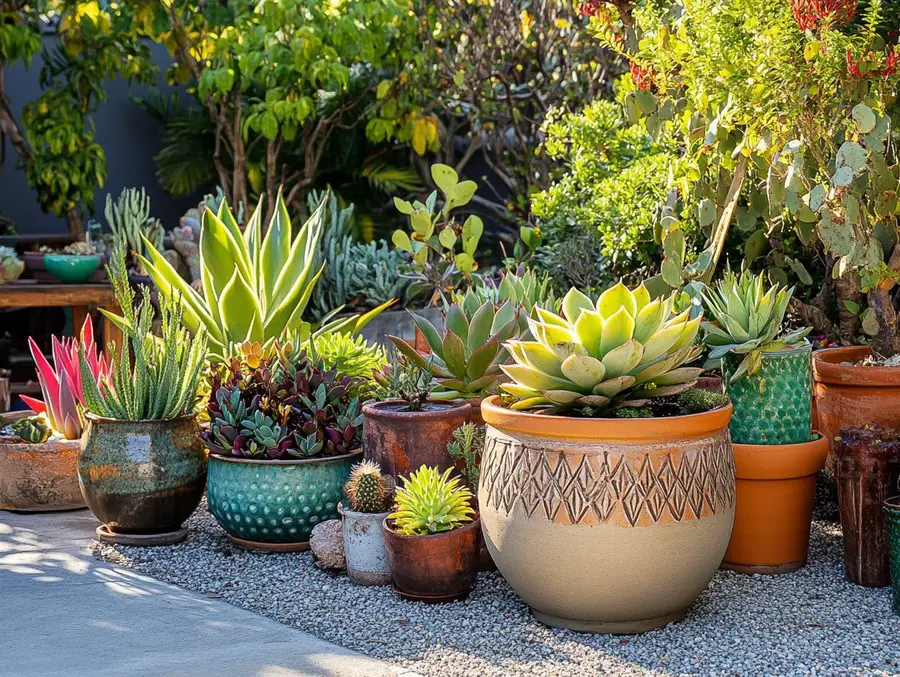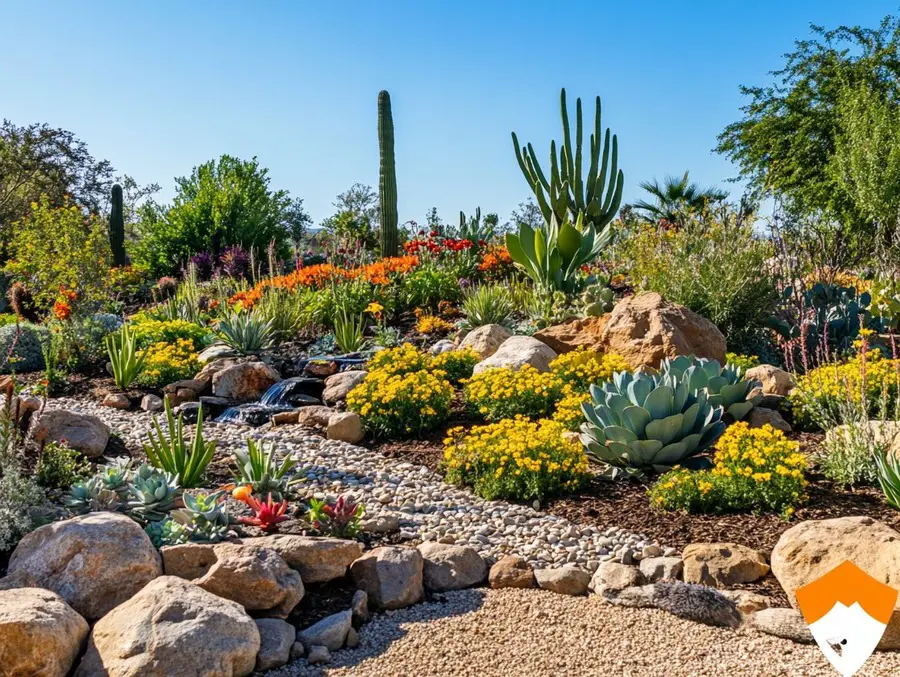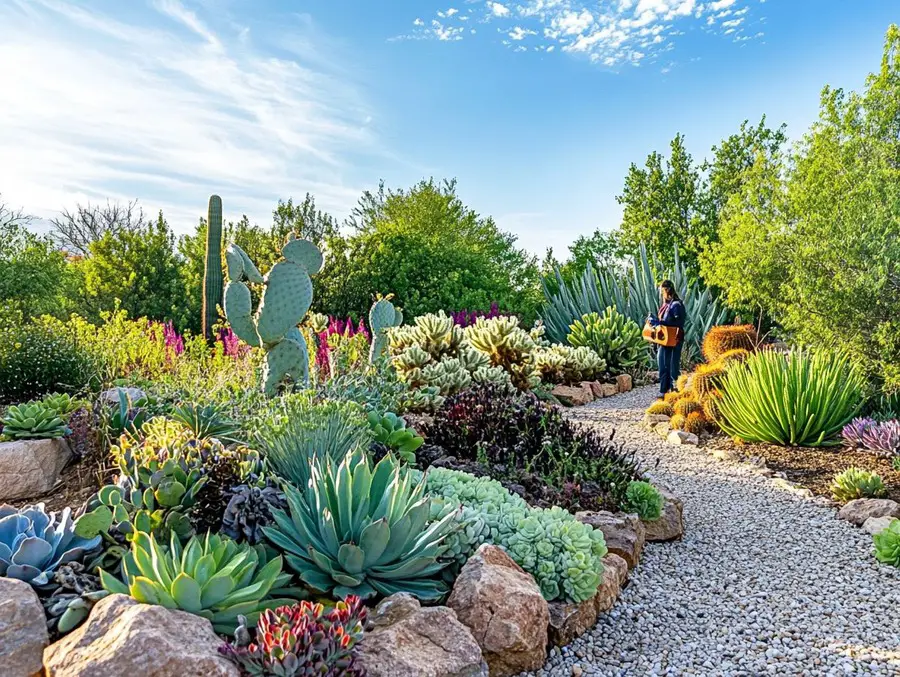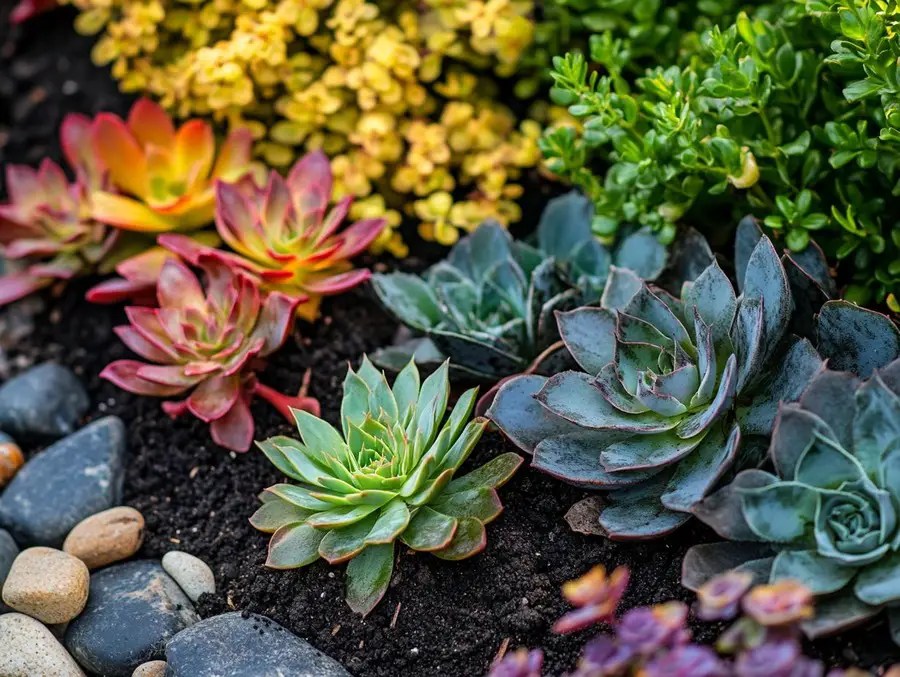We use affiliate links. If you purchase something using one of these links, we may receive compensation or commission.
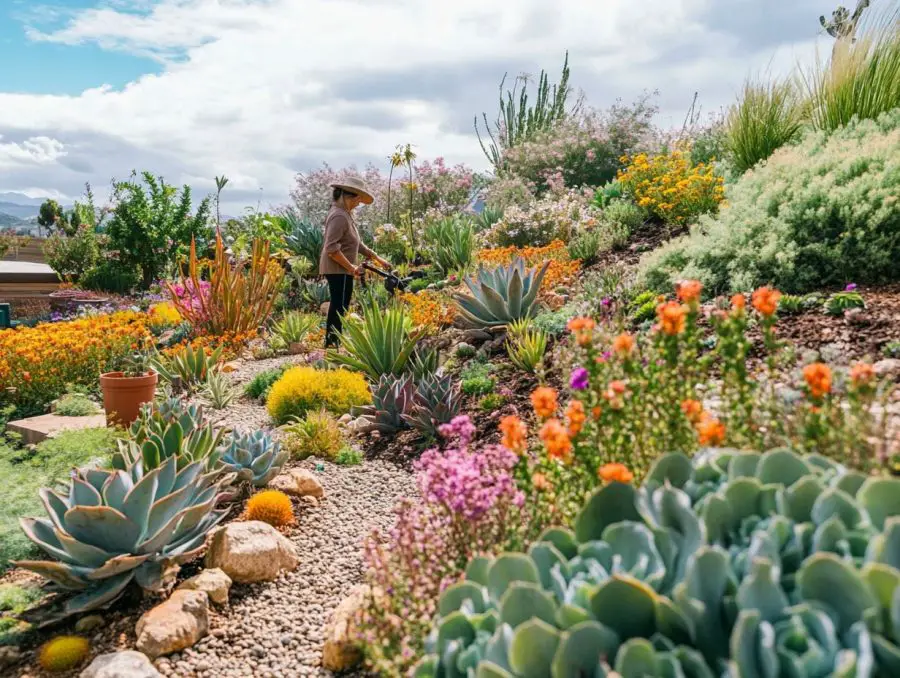
Smart Watering Techniques for Low-Water Gardens help you keep your plants thriving while conserving every precious drop.
Struggling with dry soil and high water bills?
With the right strategies, like drip irrigation, mulching, and choosing drought-resistant plants you can create a lush, low-maintenance garden that flourishes even in hot, dry climates.
Let’s dive into the best water-saving techniques!
Smart Watering Techniques
Key Takeaways
- Smart Watering Techniques for Low-Water Gardens include drip irrigation, mulching, and watering during cooler hours to reduce evaporation.
- Choosing drought-tolerant plants and grouping them by water needs helps maximize efficiency.
- These methods ensure plants get the right amount of moisture while conserving water, making your garden more sustainable and resilient.
Smart Watering Techniques for Low-Water Gardens: Proven Methods
Water conservation is becoming more important than ever, especially when it comes to gardening.
With climate changes and the growing issue of water scarcity, figuring out how to manage water efficiently can really make a difference for your garden and the environment.
This article dives into essential ways you can conserve water while keeping your garden thriving.
You’ll learn all about how to assess your plants’ specific water needs and implement effective watering techniques like drip irrigation and mulching.
These practical tips will help you create a sustainable and flourishing outdoor space.
Whether you’re a gardening pro or just starting out, you can jump in and help cultivate a greener future with some smart, water-saving practices.
The Importance of Water Conservation in Gardening
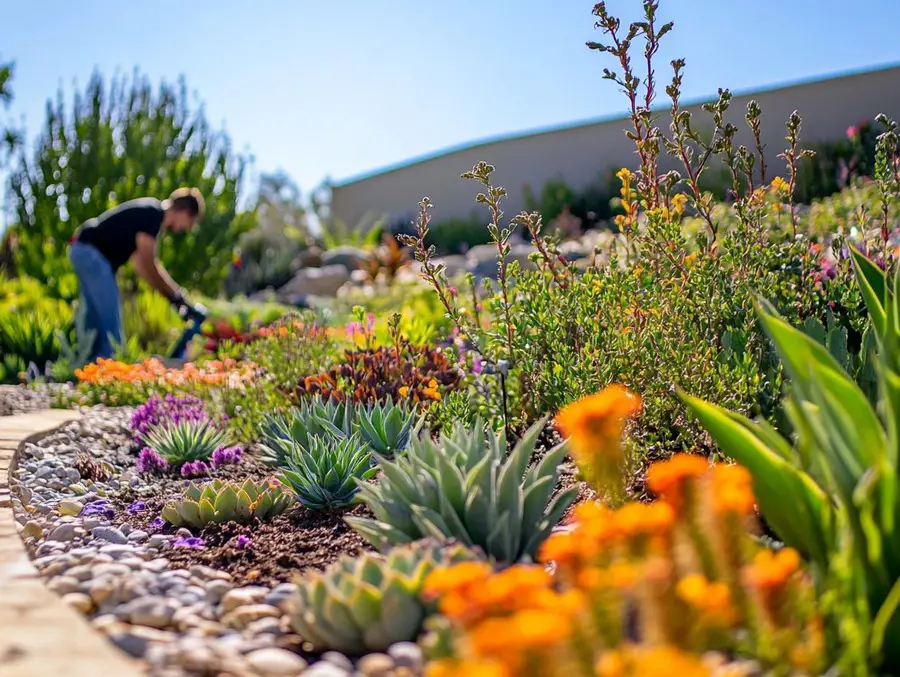
Water conservation is super important when it comes to gardening. It helps your plants stay healthy and supports sustainable practices and smart resource management.
With all the buzz around climate change and water scarcity, it’s essential for you as a gardener to find ways to cut down on water use while keeping your garden thriving.
By embracing eco-friendly practices like low-water gardens and efficient irrigation techniques, you can create a beautiful space that flourishes even in tough weather.
This approach boosts your garden’s beauty and plays a part in the overall health of our ecosystems and communities.
Why is Water Conservation Important for Gardens?
Water conservation is crucial for your garden because it directly impacts plant health, sustainability, and the overall ecological footprint of your gardening efforts.
By adopting eco-friendly practices like drip irrigation, rainwater harvesting, and mulching, you can significantly cut down on water waste while boosting nutrient retention in the soil.
When you use water wisely, your plants grow stronger and become more resilient to drought and disease.
Conserving water helps maintain local ecosystems, ensuring that the nearby flora and fauna have the resources they need to thrive.
Your commitment to sustainable gardening techniques doesn’t just help you meet your personal gardening goals.
It also plays a part in creating a healthier planet for future generations.
Understanding Your Garden’s Water Needs
Understanding your garden’s water needs is key to effective watering and making sure your plants thrive while saving water.
Different plants need different amounts of moisture, so by checking your soil types and using some soil moisture management techniques, you can really optimize your irrigation schedule.
And don’t underestimate the power of moisture sensors. They can be a game changer for figuring out when and how much to water.
This way, you can tailor your watering to meet the specific needs of your garden beds and boost the overall health of your plants.
Determining the Right Amount of Water for Your Garden
Figuring out the right amount of water for your garden is key to keeping your plants healthy and ensuring that your soil retains moisture effectively.
You can assess your plants’ hydration needs using a variety of methods to make sure each type gets just the right amount of water based on its specific requirements.
Tools like moisture meters and soil probes are super helpful for checking the moisture levels in your soil, so you can make smart choices about how much to irrigate.
Using techniques like drip irrigation saves water and delivers it directly to the roots where it’s needed most.
It’s essential to find the right balance when it comes to watering, especially as your plants go through different growth stages.
Implementing strategies to boost moisture retention can really help create a thriving garden ecosystem.
Effective Watering Techniques for Low-Water Gardens
Using effective watering techniques is crucial for keeping your low-water garden thriving.
This way, your plants get the moisture they need without wasting those precious resources.
Drip Irrigation Systems
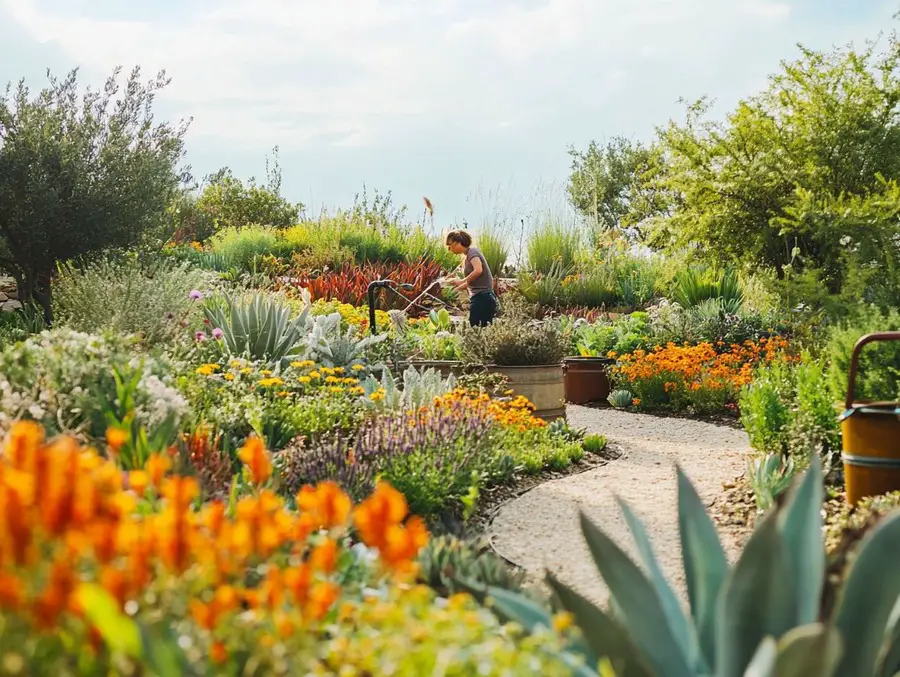
Drip irrigation systems are a fantastic way for you to provide targeted watering directly to the roots of your plants.
This method significantly cuts down on water waste and helps keep your soil healthy.
By using a network of tubes and emitters, these systems give you a consistent and measured flow of water that you can adjust based on the specific needs of your crops.
This precision helps you maintain optimal moisture levels in the soil, preventing over-saturation and ensuring that your plants effectively absorb nutrients.
By applying water directly where it’s needed, drip irrigation reduces evaporation and runoff, making your watering practices more sustainable and responsible.
As a result, your plants thrive with better growth rates, but the soil structure also improves, creating a healthier ecosystem that supports beneficial microorganisms.
Mulching and Soil Moisture Retention
Mulching is essential for retaining soil moisture, acting like a protective blanket that cuts down on evaporation and keeps your garden beds healthy and hydrated.
You have plenty of mulch options to choose from, whether you prefer organic materials like wood chips, straw, or grass clippings, or you lean towards inorganic choices such as gravel and plastic.
Each type brings its own set of unique benefits, sprucing up your garden’s look and playing a crucial role in conserving water.
For example, organic mulches will break down over time, enriching the soil and helping your plants thrive.
On the flip side, inorganic mulches offer long-lasting coverage that keeps pesky weeds at bay and reduces the need for water-saving gadgets.
By strategically using mulch, you’ll make a big difference in your garden maintenance, keeping the soil healthy and ensuring your gardening environment flourishes sustainably.
Choosing Drought-Tolerant Plants
Selecting drought-tolerant plants is a smart move when you want to create a low-water garden that can thrive in dry conditions with minimal irrigation.
By choosing native plants, you can really amp up your landscape, since these species are naturally equipped to handle dry climates and even attract local wildlife.
When you’re looking into water-efficient landscaping techniques, it’s important to consider the specific needs of the plants in your area.
Many native options help conserve water and boost soil health and cut down on the need for chemical fertilizers.
By incorporating a variety of these tough plants, you’ll create a diverse ecosystem that supports pollinators, making them a fantastic choice for sustainable gardening that adapts to our changing climate.
Other Ways to Conserve Water in Your Garden
Besides using efficient watering techniques, you can explore plenty of other ways to conserve water in your garden.
Think about rainwater harvesting and greywater recycling.
Rainwater Harvesting
Rainwater harvesting is a fantastic, sustainable practice that lets you collect and store rainwater for irrigation, giving your garden’s water conservation efforts a serious boost.
By setting up effective systems, you can cut down on your reliance on traditional water sources and even help create a healthier ecosystem.
There are all sorts of techniques for capturing and using rainwater, from simple rain barrels to more advanced underground storage tanks with filtration systems.
These methods give you a dependable water supply during dry spells and also help recharge groundwater levels and reduce surface runoff, which can lead to erosion and pollution.
In the end, embracing rainwater harvesting makes for a more resilient environment.
It supports the needs of your garden and local wildlife while promoting sustainable practices in your community.
Greywater Recycling
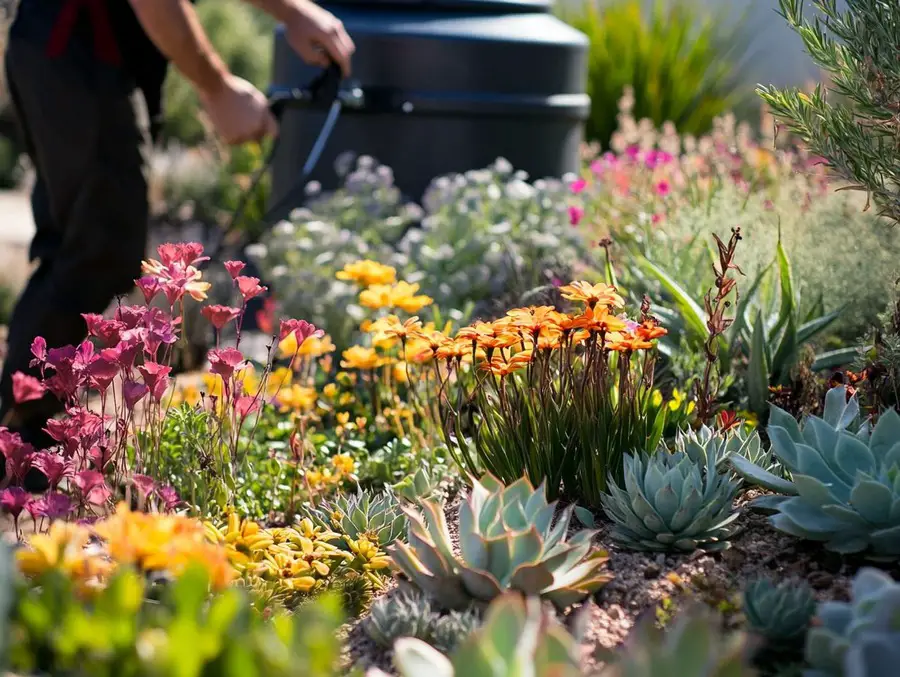
Greywater recycling is a smart and innovative way for you to conserve water by reusing wastewater from your sinks, showers, and washing machines for irrigation in your garden.
This practice helps with resource management and promotes sustainable gardening techniques that can really boost your soil health.
By redirecting treated greywater back into your landscape, you can keep your green spaces thriving while easing the strain on municipal water systems.
Using this water-efficient method means you can nurture your plants without relying heavily on clean drinking water, making it a perfect solution if you’re in a drought-prone area.
Getting to know the right systems for collecting and using greywater can lead to healthier gardens, as this recycled water often comes packed with nutrients that are great for plant growth.
Tips for Maintaining a Low-Water Garden
To keep your low-water garden thriving, you’ll need to use some specific strategies that help your plants flourish while also cutting down on water usage.
Focus on effective landscape maintenance techniques to make the most out of every drop!
Proper Pruning and Soil Management
Proper pruning and effective soil management are key to keeping your low-water garden thriving.
They play a big role in plant health and how well your garden retains water.
When you remove dead or overcrowded branches, you’re not just promoting healthier growth and you’re also making your landscape look a lot better.
Well-trimmed plants allow air and sunlight to reach them more easily, which is essential for photosynthesis and lush greenery.
By incorporating organic matter into your soil, you’ll improve its structure and significantly boost its moisture-retaining abilities.
This combination of smart pruning and attentive soil care creates a happy environment for your plants, minimizing the need for excessive watering while ensuring your garden stays vibrant and visually appealing.
Frequently Asked Questions
What are smart watering techniques for low-water gardens?
Smart watering techniques for low-water gardens are methods of efficiently and effectively watering gardens that require less water than traditional gardens.
These techniques include using drip irrigation, mulching, choosing drought-resistant plants, and adjusting watering schedules based on weather and soil moisture.
How can drip irrigation be used as a smart watering technique for low-water gardens?
Drip irrigation is a method of watering that delivers water directly to the base of plants, minimizing water loss through evaporation and run-off.
This efficient watering technique is ideal for low-water gardens as it can reduce water usage by up to 50%.
What is mulching and how does it help with low-water gardens?
Mulching involves covering the soil around plants with a layer of organic material, such as wood chips or leaves.
This helps to retain moisture in the soil, reducing the need for frequent watering.
It also helps to suppress weed growth and improve soil health.
How can choosing drought-resistant plants contribute to smart watering in low-water gardens?
Drought-resistant plants, also known as xeriscaping plants, are able to thrive in dry conditions and require less water than traditional plants.
By selecting these types of plants for your low-water garden, you can reduce the amount of water needed for maintenance.
Why is it important to adjust watering schedules based on weather and soil moisture for low-water gardens?
The amount of water needed for a garden can vary depending on the weather and soil moisture levels.
By regularly monitoring these factors and adjusting watering schedules accordingly, you can avoid over or under watering your low-water garden, which can lead to plant stress and disease.
Are there any other tips for implementing smart watering techniques in low-water gardens?
The techniques mentioned above, it’s important to properly maintain irrigation systems, check for leaks, and water in the early morning or evening to minimize water loss through evaporation.
It’s also helpful to group plants with similar watering needs together and to use rain barrels or other water catchment systems.
Best Plants for Xeriscape Gardens: Hardy & Beautiful
Xeriscape Garden Styles: Easy Low-Maintenance Options
Xeriscape Gardening Techniques: Easy Low-Water Tips
Xeriscape Garden Design & Layout: Easy Water-Wise Beauty
What is xeriscaping? A beginner’s guide to drought-tolerant landscaping – Colorado State University
Related Content
Visit my Amazon Influencer Page for videos and gardening products Grow Your Own Garden

